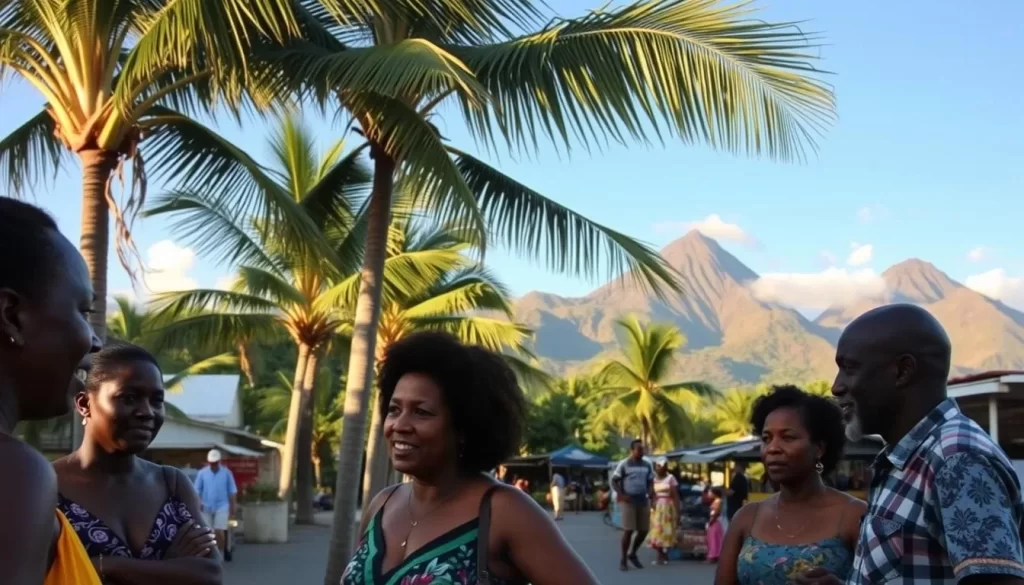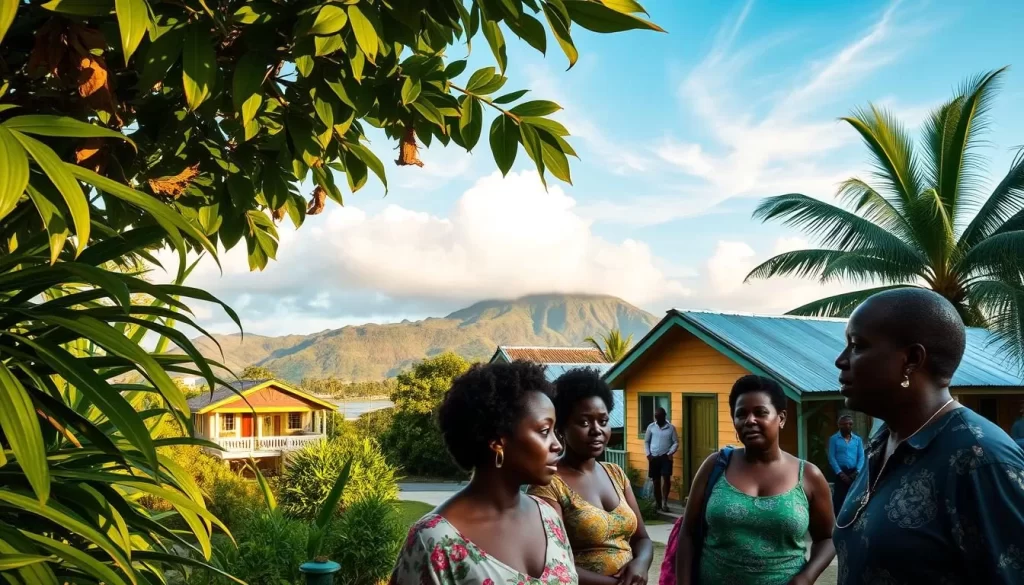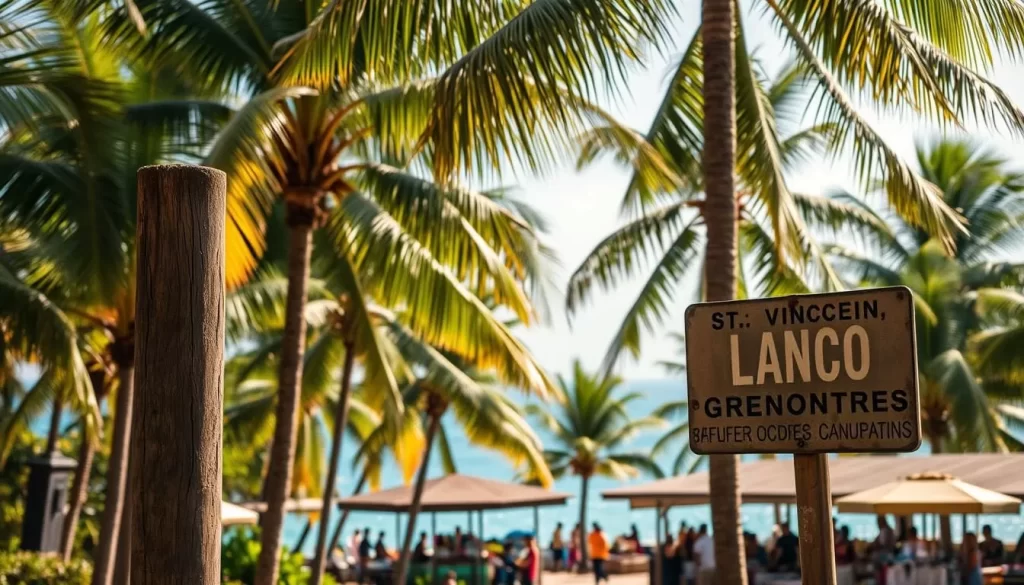Welcome to the vibrant nation of Saint Vincent and the Grenadines, a Caribbean gem known for its rich culture and diverse linguistic heritage. Here, English stands as the official language, used in government, education, and formal settings. However, the island’s heartbeat is also shaped by Vincentian Creole, a widely spoken dialect in everyday conversations.
The country’s linguistic landscape is deeply rooted in its colonial past. British influence established English as the primary language, while African, French, and Spanish interactions gave rise to Creole. This blend reflects the island’s unique history and cultural fusion.
As you explore this article, you’ll uncover how historical events shaped the language preferences of today. From the capital, Kingstown, to the smaller islands, the linguistic tapestry of Saint Vincent and the Grenadines tells a story of resilience and adaptation.
: Overview of Linguistic Diversity in St. Vincent & The Grenadines
Discover the rich linguistic tapestry of this Caribbean nation. Its language landscape is a reflection of centuries of cultural exchange and historical events. From pre-colonial times to modern-day interactions, the evolution of communication here tells a fascinating story.

Historical Influences on Language
Before European contact, indigenous Caribs spoke their native tongues. These languages were gradually replaced or adapted during colonization. The arrival of African slaves brought new dialects, blending with European languages like English and French.
Forced interactions among slaves led to the creation of Vincentian Creole. This unique dialect evolved as a mix of African, French, and English elements. Key historical moments, such as treaties and wars, further shaped the linguistic landscape.
The Modern Language Landscape
Today, the country’s language use reflects its diverse heritage. English remains dominant in formal settings, while Creole thrives in everyday conversations. This blend of formal and informal communication highlights the island’s cultural resilience.
| Historical Period | Language Influence |
|---|---|
| Pre-Colonial | Indigenous Carib languages |
| Colonial Era | English, French, African dialects |
| Modern Day | English, Vincentian Creole |
From names to everyday phrases, the island’s language heritage is deeply rooted in its history. Understanding this evolution offers insight into the vibrant culture of Saint Vincent Grenadines.
: The Role of English as the Official Language
English plays a central role in shaping the identity of this Caribbean nation. As the official language, it is deeply embedded in education, media, and governance. Its use reflects the island’s colonial past and its status as a Commonwealth member.
Impact on Education and Media
In schools, English is the primary medium of instruction. From primary to higher education, students learn and communicate in this language. This ensures that the population is well-prepared for global opportunities.
Media outlets, including newspapers, radio, and television, also rely on English. This helps unify the nation and keeps citizens informed. The language’s dominance in media reinforces its importance in daily life.
Government, Legal, and Daily Use
English is the cornerstone of government and legal systems. Official documents, laws, and public announcements are all in this language. This ensures clarity and consistency in governance.
In everyday interactions, English is widely used alongside Creole. Whether in markets or offices, it bridges communication gaps. This dual-language use highlights the island’s cultural richness.
From the prime minister’s speeches to street signs, English is everywhere. Its presence is a testament to the nation’s history and its embrace of global culture.
: St. Vincent & The Grenadines: Official and widely spoken languages
Explore the unique blend of languages that define this Caribbean nation. Here, English holds official status, used in government, education, and media. Yet, the island’s heart beats in Vincentian Creole, a vibrant dialect spoken in daily life.

This dual language use reflects the population’s cultural richness. English ensures clarity in formal settings, while Creole connects people on a personal level. Together, they paint a picture of resilience and adaptation.
Historical milestones shaped this linguistic landscape. Over the century, colonial influences and demographic shifts created a unique blend. Today, the island’s language policies reinforce English as the official tongue, while Creole thrives in homes and markets.
Public figures, like the prime minister, play a key role in promoting language and culture. Their speeches often highlight the importance of preserving both English and Creole. This balance ensures that the nation’s heritage remains alive.
- English dominates formal communications, from laws to education.
- Vincentian Creole enriches cultural identity in everyday interactions.
- Historical events shaped the current language status.
From Kingstown to smaller villages, the linguistic tapestry of this island tells a story of unity and diversity. Understanding this blend offers insight into the history and culture of Saint Vincent Grenadines.
: Examining Vincentian Creole and French Patois
The linguistic heritage of this Caribbean island is a fascinating blend of history and culture. Two key elements stand out: Vincentian Creole and French Patois. These dialects reflect the nation’s diverse roots and its journey through time.

Cultural and Historical Roots
Vincentian Creole emerged during the colonial era, shaped by the transatlantic slave trade. Enslaved Africans, brought to the island, blended their native tongues with English, French, and Spanish. This mix created a unique dialect for communication.
French Patois, on the other hand, traces its origins to European settlers. Communities with French ancestry preserved this dialect, adding another layer to the nation’s linguistic tapestry. Over the years, both dialects evolved, influenced by local customs and global interactions.
Distinct Linguistic Features
Vincentian Creole is known for its simplified grammar and vibrant expressions. For example, the word “town” often becomes “tung” in local speech. This reflects the dialect’s adaptability and its role in everyday life.
French Patois retains elements of its European roots, with distinct pronunciation and vocabulary. It serves as a bridge to the world’s Francophone communities, highlighting the island’s global connections.
| Dialect | Key Features |
|---|---|
| Vincentian Creole | Simplified grammar, African and European influences |
| French Patois | European roots, distinct pronunciation |
These dialects are more than just ways of speaking. They are symbols of identity and resilience. For more insights into Vincentian Creole, explore its historical and cultural significance.
: Influence of History on Language Evolution
The story of language in this Caribbean nation is a journey through time and culture. From colonial rule to modern-day interactions, the island’s linguistic landscape has been shaped by a series of historical events. Understanding this evolution offers insight into the resilience and adaptability of its population.

Colonial Legacies and Demographic Shifts
Colonial rule left a lasting mark on the language of this island. British influence established English as the dominant tongue, while French and Spanish settlers added their own dialects. The arrival of African slaves introduced new linguistic elements, blending with European languages to create unique creoles.
Key events, such as the Carib wars and the emancipation of slaves in 1834, further shaped the island’s communication. These shifts in governance and population led to a series of linguistic changes, reflecting the world’s broader cultural trends.
Religion also played a role in legitimizing certain languages. Missionaries promoted English in formal settings, while local dialects thrived in everyday life. This dual-language use highlights the island’s ability to adapt and preserve its heritage.
Today, the language landscape continues to evolve. Global influences and local traditions ensure that the island’s linguistic tapestry remains vibrant and diverse. Understanding this history helps you appreciate the rich cultural identity of saint vincent grenadines.
: Practical Insights for Visitors and Locals
Navigating the linguistic landscape of this Caribbean gem offers a unique cultural experience. Whether you’re a visitor or a local, understanding the language dynamics can enrich your interactions and deepen your connection to the island.
Language in Social and Cultural Settings
In social settings, Vincentian Creole is the heart of everyday communication. Locals often use it in markets, restaurants, and community gatherings. For visitors, learning a few phrases can go a long way in building rapport.
Cultural events like Carnival and the Breadfruit Festival showcase the nation’s vibrant traditions. During these celebrations, you’ll hear a mix of English and Creole, reflecting the population’s diverse heritage.
Practical Tips for Communication
Here are some tips to help you navigate the language scene:
- Use simple English in formal settings like government offices or banks.
- In informal settings, try using common Creole phrases like “Wha’ goin’ on?” (What’s going on?) to connect with locals.
- Be mindful of regional differences. Urban centers like Kingstown may have more English speakers, while rural areas lean heavily on Creole.
Language Across Generations
Older generations often prefer Creole, while younger people may switch between English and Creole. This generational shift highlights the evolving language landscape of the island.
| Setting | Language Use |
|---|---|
| Markets | Creole dominates, with some English for tourists. |
| Restaurants | English menus, but staff may speak Creole. |
| Public Services | English is standard, but Creole is common in informal interactions. |
By embracing the language diversity, you’ll gain a deeper appreciation for the culture and people of this beautiful nation. Whether you’re exploring Kingstown or a quiet village, your efforts to connect will be warmly welcomed.
: Conclusion
The linguistic journey of this Caribbean island reflects its rich history and cultural resilience. English holds official status, shaping education, governance, and media. Meanwhile, Vincentian Creole thrives in daily life, connecting the population on a personal level.
Historical influences, from colonial rule to the transatlantic slave trade, have shaped this unique blend. Over the years, African, French, and English elements merged, creating a vibrant linguistic tapestry. Today, this duality highlights the country’s ability to adapt while preserving its heritage.
For visitors, understanding this blend enriches interactions. Simple English works in formal settings, while Creole phrases like “Wha’ goin’ on?” build rapport. Annual events, like Carnival, showcase this linguistic diversity, celebrating the island’s identity.
Public figures, including the prime minister, play a key role in promoting both languages. Their efforts ensure that the status of English and Creole remains balanced, fostering unity and pride. As the language landscape continues to evolve, it remains a testament to the resilience and vibrancy of saint vincent grenadines.
The above is subject to change.
Check back often to TRAVEL.COM for the latest travel tips and deals.
Here are some Tours & Sightseeing suggestions that might pique your interests!






